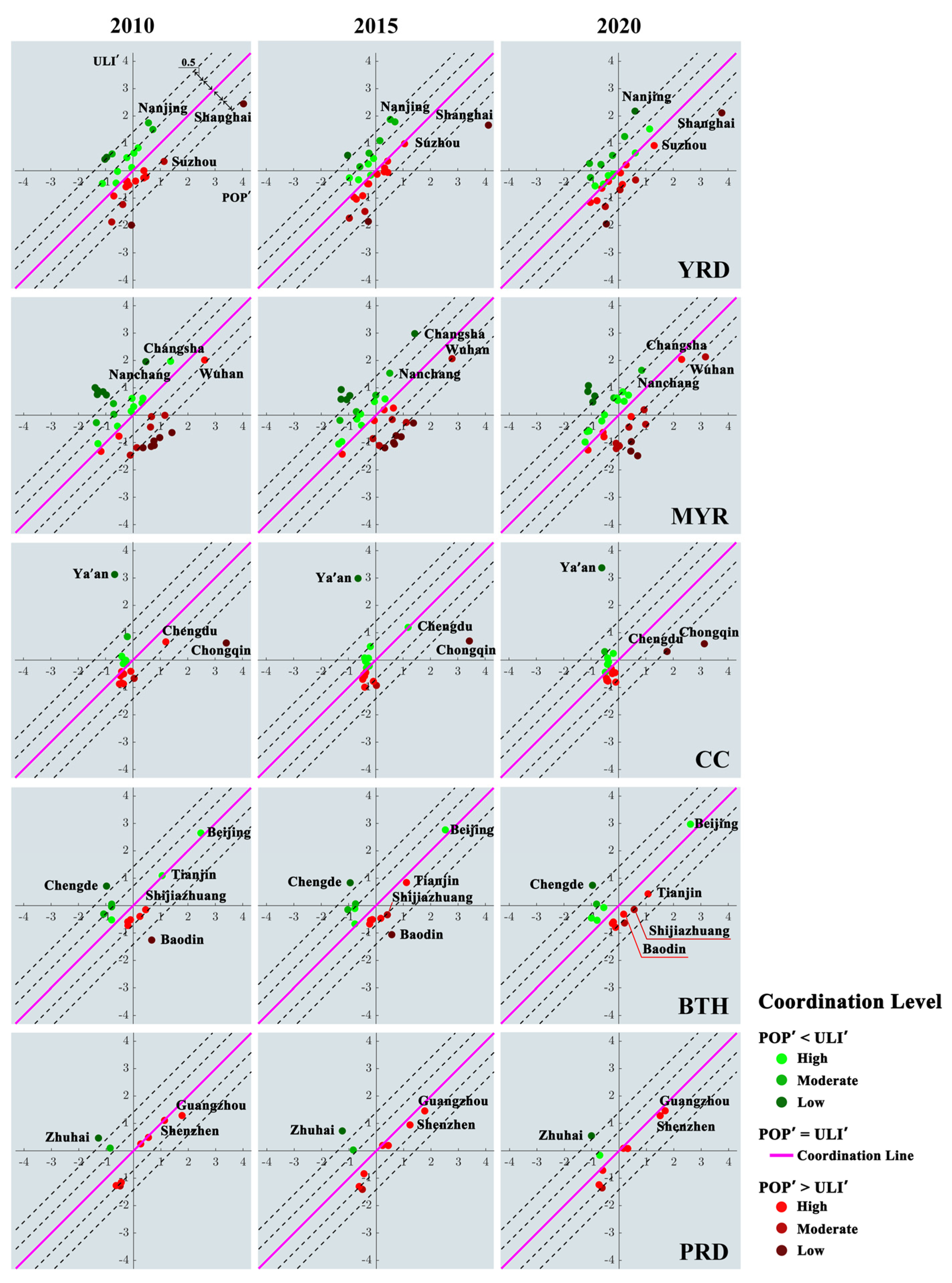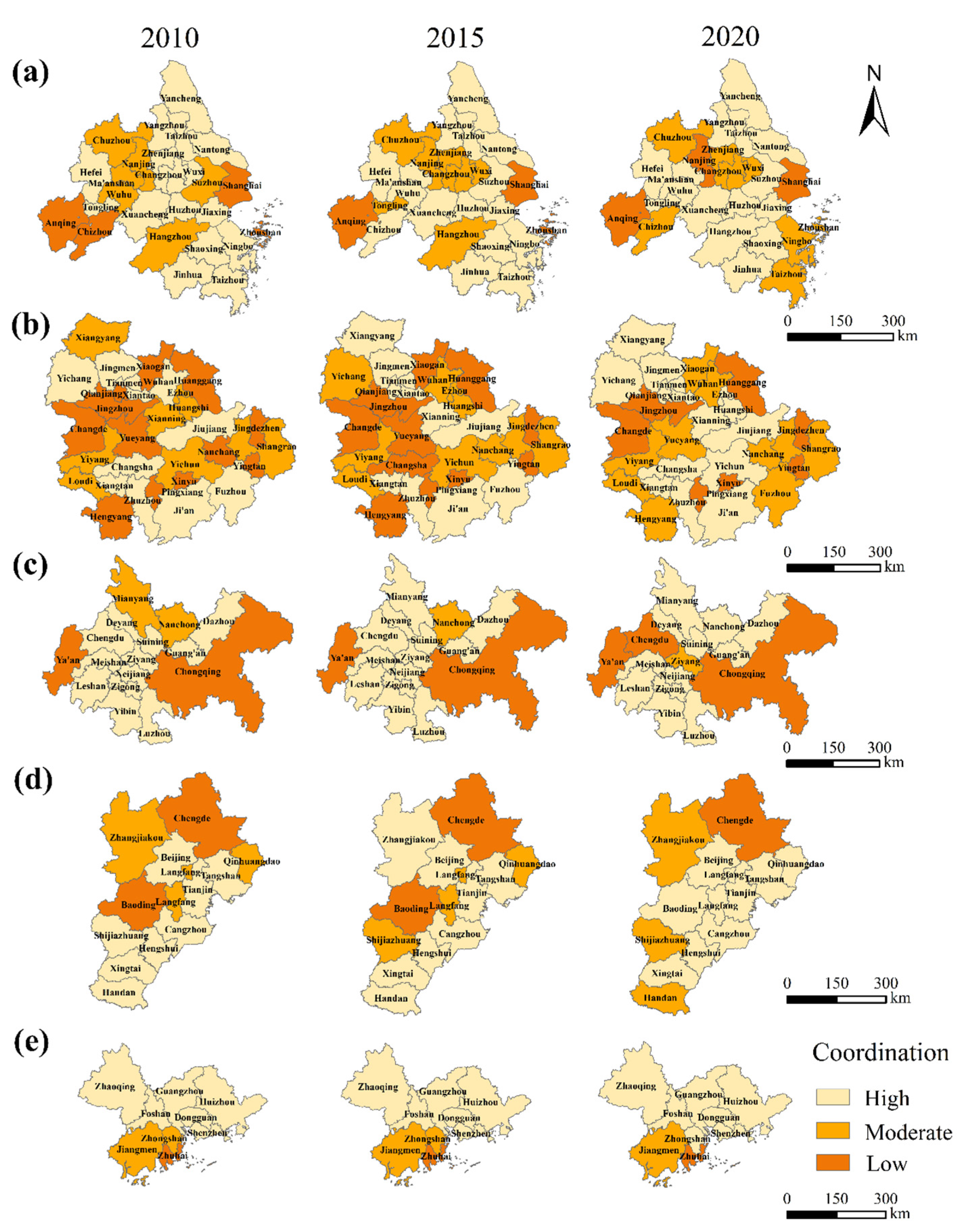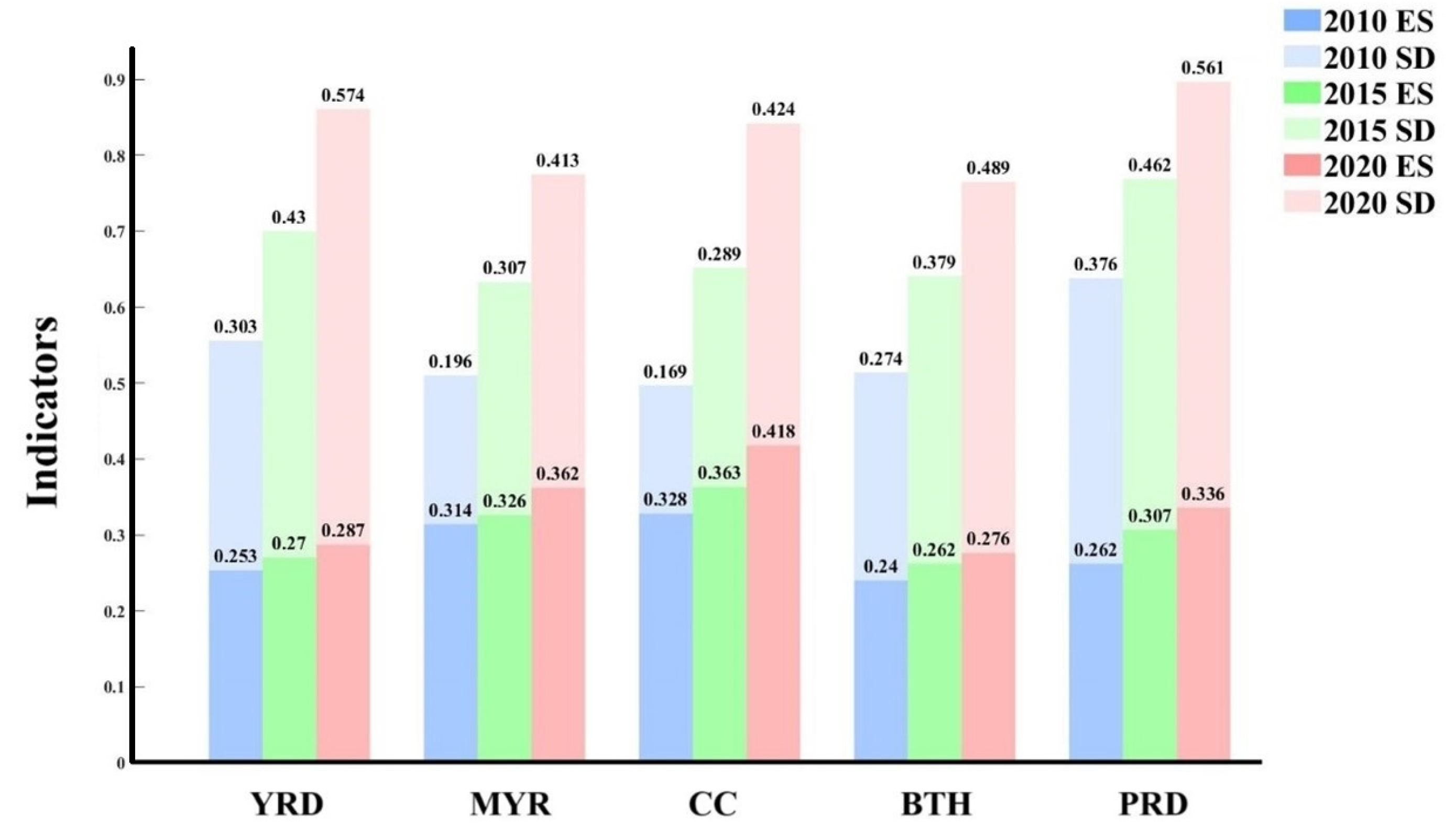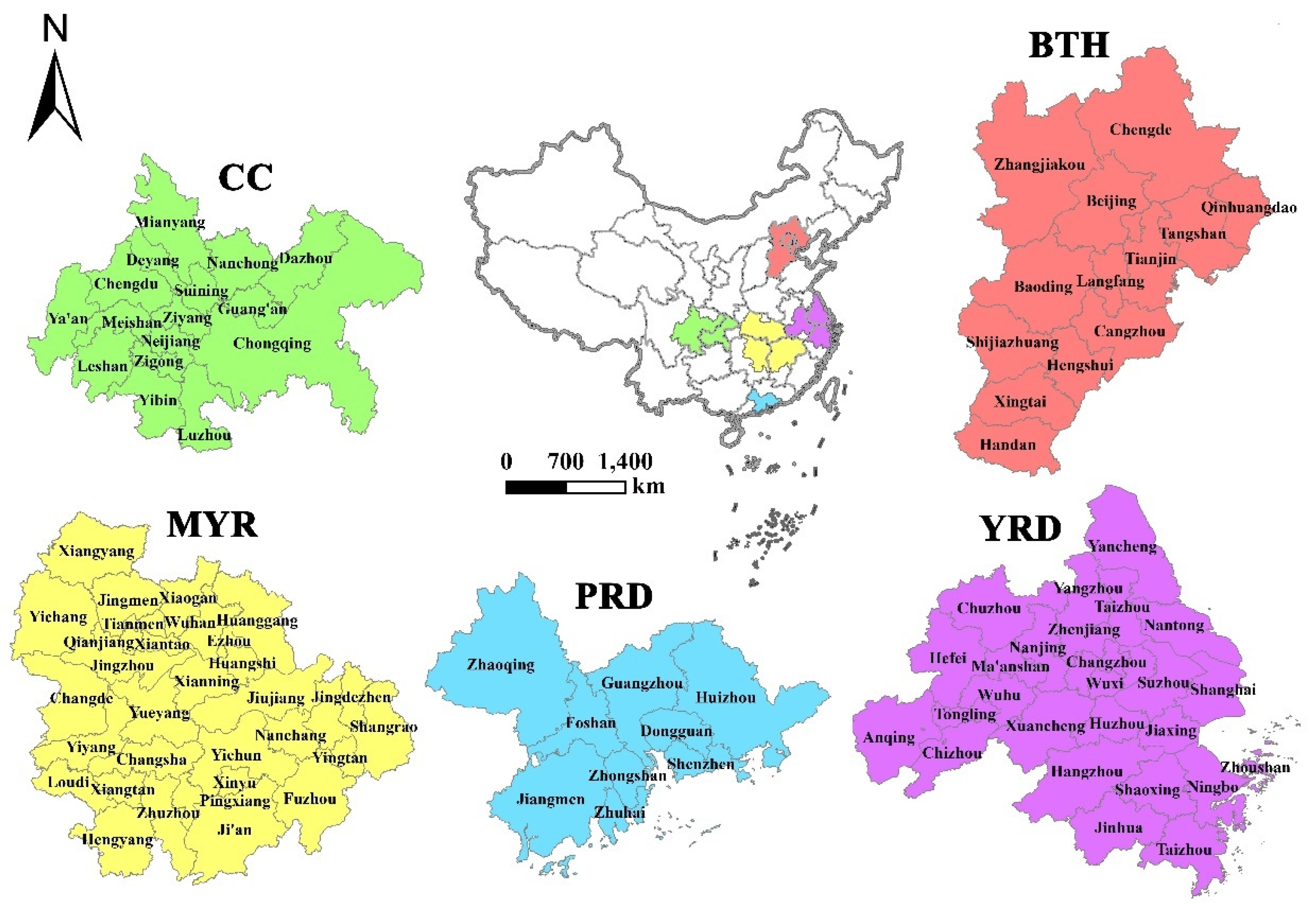Coordination Analysis Between Urban Livability and Population Distribution in China’s Major Urban Agglomerations
Abstract
1. Introduction
2. Materials and Methods
2.1. Study Area
2.2. Indices for Urban Livability
2.3. Index for the Coordination Between Urban Livability and Population Distribution
3. Results
3.1. Coordination Evaluation for Cities Within Urban Agglomerations


3.2. Coordination Levels of Urban Agglomerations

4. Discussion
4.1. Indicators on Urban Livability Evaluation

4.2. Limitations
5. Conclusions
Author Contributions
Funding
Institutional Review Board Statement
Informed Consent Statement
Data Availability Statement
Conflicts of Interest
References
- Jiang, L.; O’neill, B.C. Global urbanization projections for the Shared Socioeconomic Pathways. Glob. Environ. Chang. 2017, 42, 193–199. [Google Scholar] [CrossRef]
- Gu, C. Urbanization: Processes and driving forces. Sci. China Earth Sci. 2019, 62, 1351–1360. [Google Scholar] [CrossRef]
- Sun, L.; Chen, J.; Li, Q.; Huang, D. Dramatic uneven urbanization of large cities throughout the world in recent decades. Nat. Commun. 2020, 11, 5366. [Google Scholar] [CrossRef] [PubMed]
- Capps, K.A.; Bentsen, C.N.; Ramírez, A. Poverty, urbanization, and environmental degradation: Urban streams in the developing world. Freshw. Sci. 2016, 35, 429–435. [Google Scholar] [CrossRef]
- Ye, C.; Schröder, P.; Yang, D.; Chen, M.; Cui, C.; Zhuang, L. Toward healthy and livable cities: A new framework linking public health to urbanization. Environ. Res. Lett. 2022, 17, 064035. [Google Scholar] [CrossRef]
- Wang, Y.; Miao, Z. Towards the analysis of urban livability in China: Spatial–temporal changes, regional types, and influencing factors. Environ. Sci. Pollut. Res. 2022, 29, 60153–60172. [Google Scholar] [CrossRef]
- United Nations Department of Economic and Social Affairs (UNDESA). World Urbanization Prospects: The 2018 Revision. 2018. Available online: https://www.un.org/en/desa/2018-revision-world-urbanization-prospects (accessed on 24 November 2024).
- Qadeer, M.A. Urbanization by implosion. Habitat Int. 2004, 28, 1–12. [Google Scholar] [CrossRef]
- Liu, Y.; Zhang, X.; Pan, X.; Ma, X.; Tang, M. The spatial integration and coordinated industrial development of urban agglomerations in the Yangtze River Economic Belt, China. Cities 2020, 104, 102801. [Google Scholar] [CrossRef]
- Tan, R.; Zhou, K.; He, Q.; Xu, H. Analyzing the effects of spatial interaction among city clusters on urban growth—Case of Wuhan urban agglomeration. Sustainability 2016, 8, 759. [Google Scholar] [CrossRef]
- United Nations. Department of Economic and Social Affairs, Open Working Group Proposal for Sustainable Development Goals. 2015. Available online: https://sdgs.un.org/partnerships (accessed on 24 November 2024).
- Martins, M.S.; Fundo, P.; Kalil, R.M.L.; Rosa, F.D. Community participation in the identification of neighbourhood sustainability indicators in Brazil. Habitat Int. 2021, 113, 102370. [Google Scholar] [CrossRef]
- Valentin, A.; Spangenberg, J.H. A guide to community sustainability indicators. Environ. Impact Assess. Rev. 2000, 20, 381–392. [Google Scholar] [CrossRef]
- Paul, A.; Sen, J. Livability assessment within a metropolis based on the impact of integrated urban geographic factors (IUGFs) on clustering urban centers of Kolkata. Cities 2018, 74, 142–150. [Google Scholar] [CrossRef]
- Paul, A. Developing a methodology for assessing livability potential: An evidence from a metropolitan urban agglomeration (MUA) in Kolkata, India. Habitat Int. 2020, 105, 102263. [Google Scholar] [CrossRef]
- Parker, J.; Simpson, G.D. Public green infrastructure contributes to city livability: A systematic quantitative review. Land 2018, 7, 161. [Google Scholar] [CrossRef]
- Martino, N.; Girling, C.; Lu, Y. Urban form and livability: Socioeconomic and built environment indicators. Build. Cities 2021, 2, 220–243. [Google Scholar] [CrossRef]
- Yang, J.; Wu, T.; Gong, P. Implementation of China’s new urbanization strategy requires new thinking. Sci. Bull. 2017, 62, 81–82. [Google Scholar] [CrossRef]
- Ministry of Civil Affairs of the People’s Republic of China. Statistical Table of Administrative Divisions of the People’s Republic of China. Available online: http://xzqh.mca.gov.cn/statistics/ (accessed on 24 November 2024).
- Fang, C.; Yu, D. Urban agglomeration: An evolving concept of an emerging phenomenon. Landsc. Urban Plan. 2017, 162, 126–136. [Google Scholar] [CrossRef]
- Douglass, M. From global intercity competition to cooperation for livable cities and economic resilience in Pacific Asia. Environ. Urban. 2002, 14, 53–68. [Google Scholar] [CrossRef]
- Geng, Y.; Fujita, T.; Bleischwitz, R.; Chiu, A.; Sarkis, J. Accelerating the transition to equitable, sustainable, and livable cities: Toward post-fossil carbon societies. J. Clean. Prod. 2019, 239, 118020. [Google Scholar] [CrossRef]
- Henderson, J.V. Urbanization and economic development. Ann. Econ. Financ. 2003, 4, 275–342. [Google Scholar]
- Liu, S.; Liao, Q.; Liang, Y.; Li, Z.; Huang, C. Spatio–Temporal Heterogeneity of Urban Expansion and Population Growth in China. Int. J. Environ. Res. Public Health 2021, 18, 13031. [Google Scholar] [CrossRef] [PubMed]
- Zhang, R.; Jiang, G.; Zhang, Q. Does urbanization always lead to rural hollowing? Assessing the spatio-temporal variations in this relationship at the county level in China 2000–2015. J. Clean. Prod. 2019, 220, 9–22. [Google Scholar] [CrossRef]
- He, Q.; Zeng, C.; Xie, P.; Tan, S.; Wu, J. Comparison of urban growth patterns and changes between three urban agglomerations in China and three metropolises in the USA from 1995 to 2015. Sustain. Cities Soc. 2019, 50, 101649. [Google Scholar] [CrossRef]
- Seto, K.C.; Sánchez-Rodríguez, R.; Fragkias, M. The new geography of contemporary urbanization and the environment. Annu. Rev. Environ. Resour. 2010, 35, 167–194. [Google Scholar] [CrossRef]
- Zhan, D.; Kwan, M.-P.; Zhang, W.; Fan, J.; Yu, J.; Dang, Y. Assessment and determinants of satisfaction with urban livability in China. Cities 2018, 79, 92–101. [Google Scholar] [CrossRef]
- Zhang, Y.; Li, Y.; Chen, Y.; Liu, S.; Yang, Q. Spatiotemporal heterogeneity of urban land expansion and urban population growth under new urbanization: A case study of Chongqing. Int. J. Environ. Res. Public Health 2022, 19, 7792. [Google Scholar] [CrossRef]
- Hossein, A.; Sarkari, F.; Borhani, M. Coupling coordination analysis between urbanization and ecology in Iran. Front. Urban Rural. Plan. 2024, 2, 5. [Google Scholar]
- Cai, J.; Li, X.; Liu, L.; Chen, Y.; Wang, X.; Lu, S. Coupling and coordinated development of new urbanization and agro-ecological environment in China. Sci. Total Environ. 2021, 776, 145837. [Google Scholar] [CrossRef]
- Lv, T.; Wang, L.; Zhang, X.; Xie, H.; Lu, H.; Li, H.; Liu, W.; Zhang, Y. Coupling coordinated development and exploring its influencing factors in Nanchang, China: From the perspectives of land urbanization and population urbanization. Land 2019, 8, 178. [Google Scholar] [CrossRef]
- Wang, D.; Jiang, D.; Fu, J.; Lin, G.; Zhang, J. Comprehensive Assessment of Production–Living–Ecological Space Based on the Coupling Coordination Degree Model. Sustainability 2020, 12, 2009. [Google Scholar] [CrossRef]
- Xu, Z.; Yin, Y. Regional Development Quality of Yangtze River Delta: From the Perspective of Urban Population Agglomeration and Ecological Efficiency Coordination. Sustainability 2021, 13, 12818. [Google Scholar] [CrossRef]
- Zeng, P.; Wei, X.; Duan, Z. Coupling and coordination analysis in urban agglomerations of China: Urbanization and ecological security perspectives. J. Clean. Prod. 2022, 365, 132730. [Google Scholar] [CrossRef]
- Jiang, S.; Zhang, Z.; Ren, H.; Wei, G.; Xu, M.; Liu, B. Spatiotemporal characteristics of urban land expansion and population growth in Africa from 2001 to 2019: Evidence from population density data. ISPRS Int. J. Geo-Inf. 2021, 10, 584. [Google Scholar] [CrossRef]
- Regueiro-Ferreira, R.M.; Alonso-Fernández, P. Ecological elasticity, decoupling, and dematerialization: Insights from the EU-15 study (1970–2018). Ecol. Indic. 2022, 140, 109010. [Google Scholar] [CrossRef]
- Cao, Y.; Zhang, Z.; Fu, J.; Li, H. Coordinated Development of Urban Agglomeration in Central Shanxi. Sustainability 2022, 14, 9924. [Google Scholar] [CrossRef]
- Hepburn, C.; Qi, Y.; Stern, N.; Ward, B.; Xie, C.; Zenghelis, D. Towards carbon neutrality and China’s 14th Five-Year Plan: Clean energy transition, sustainable urban development, and investment priorities. Environ. Sci. Ecotechnol. 2021, 8, 100130. [Google Scholar] [CrossRef]
- Xiao, R.; Yu, X.; Xiang, T.; Zhang, Z.; Wang, X.; Wu, J. Exploring the coordination between physical space expansion and social space growth of China’s urban agglomerations based on hierarchical analysis. Land Use Policy 2021, 109, 105700. [Google Scholar] [CrossRef]
- Yang, J.; Huang, X. 30 m annual land cover and its dynamics in China from 1990 to 2019. Earth Syst. Sci. Data 2021, 13, 3907–3925. [Google Scholar] [CrossRef]
- Zhang, Q.; Kong, Q.; Zhang, M.; Huang, H. New-type urbanization and ecological well-being performance: A coupling coordination analysis in the middle reaches of the Yangtze River urban agglomerations, China. Ecol. Indic. 2024, 159, 111678. [Google Scholar] [CrossRef]
- Li, X.; Lu, Z. Quantitative measurement on urbanization development level in urban Agglomerations: A case of JJJ urban agglomeration. Ecol. Indic. 2021, 133, 108375. [Google Scholar] [CrossRef]
- Cramer, W.; Field, C.B. Comparing global models of terrestrial net primary productivity (NPP): Introduction. Glob. Chang. Biol. 1999, 5, 1–15. [Google Scholar] [CrossRef]
- Christopher, G. Potential scale-related problems in estimating the costs of CO2 mitigation policies. Clim. Chang. 2000, 44, 331–349. [Google Scholar]
- Jin, J.; Li, M.; Jin, L. Data normalization to accelerate training for linear neural net to predict tropical cyclone tracks. Math. Probl. Eng. 2015, 2015, 931629. [Google Scholar] [CrossRef]
- Patro, S.G.K.; Sahu, K.K. Normalization: A preprocessing stage. arXiv 2015, arXiv:1503.06462. [Google Scholar] [CrossRef]
- Abdi, H.; Lynne, J. Williams. Normalizing data. Encycl. Res. Des. 2010, 1, 935–938. [Google Scholar]
- Liu, Y.; Yue, W.; Fan, P.; Zhang, Z.; Huang, J. Assessing the urban environmental quality of mountainous cities: A case study in Chongqing, China. Ecol. Indic. 2017, 81, 132–145. [Google Scholar] [CrossRef]
- Fu, C.; Zhang, H. Evaluation of Urban Ecological Livability from a Synergistic Perspective: A Case Study of Beijing City, China. Sustainability 2023, 15, 10476. [Google Scholar] [CrossRef]
- Lv, T.; Geng, C.; Zhang, X.; Hu, H.; Li, Z.; Zhao, Q. Spatiotemporal evolution and influencing factors of urban industrial carbon emission efficiency in the Mid-Yangtze River urban agglomeration of China. Phys. Chem. Earth Parts A/B/C 2024, 135, 103607. [Google Scholar] [CrossRef]
- Wang, J.; Su, M.; Chen, B.; Chen, S.; Liang, C. A comparative study of Beijing and three global cities: A perspective on urban livability. Front. Earth Sci. 2011, 5, 323–329. [Google Scholar] [CrossRef]
- Cao, Y.; Li, F.; Xi, X.; van Bilsen, D.J.C.; Xu, L. Urban livability: Agent-based simulation, assessment, and interpretation for the case of Futian District, Shenzhen. J. Clean. Prod. 2021, 320, 128662. [Google Scholar] [CrossRef]

| Indicators | Sub Indicators | Description | Type |
|---|---|---|---|
| Social- economic Development (SD) | GDP per capita | Statistics of per capita GDP in each city | Positive |
| Disposable income of urban residents | Statistics of per capita disposable income in each city | Positive | |
| Urban population ratio | Urban population/total resident population | Positive | |
| Per capita urban construction area | Construction land area/total resident population | Positive | |
| Number of hospital beds per 10,000 people | Number of beds/total resident population (per 10,000 people) | Positive | |
| Number of enrolled students per 10,000 people | Number of enrolled students (nursery school, primary school, middle school, university)/total resident population (per 10,000 people) | Positive | |
| Ecosystem Service (ES) | Per capita NPP | Total NPP/total resident population | Positive |
| Per capita urban green/bule space | (Forest + grassland + water area)/total resident population | Positive | |
| Per capita carbon emissions | Total carbon emissions/total resident population | Negative | |
| Energy efficiency | GDP/total carbon emissions | Positive |
| CDI Range | Coordination Level | Implication |
|---|---|---|
| CDI < −1 | Low | The current population is excessively high compared to the level of urban livability. |
| −1 ≤ CDI < −0.5 | Moderate | The current population is relatively high compared to the level of urban livability. |
| −0.5 ≤ CDI < 0.5 | High | The current population is well-coordinated with the level of urban livability. |
| 0.5 ≤ CDI < 1 | Moderate | The current population is relatively low compared to the level of urban livability. |
| 1 ≤ CDI | Low | The current population is excessively low compared to the level of urban livability |
Disclaimer/Publisher’s Note: The statements, opinions and data contained in all publications are solely those of the individual author(s) and contributor(s) and not of MDPI and/or the editor(s). MDPI and/or the editor(s) disclaim responsibility for any injury to people or property resulting from any ideas, methods, instructions or products referred to in the content. |
© 2024 by the authors. Licensee MDPI, Basel, Switzerland. This article is an open access article distributed under the terms and conditions of the Creative Commons Attribution (CC BY) license (https://creativecommons.org/licenses/by/4.0/).
Share and Cite
Ran, Y.; Hou, W.; Sun, J.; Zhai, L.; Du, C.; Li, J. Coordination Analysis Between Urban Livability and Population Distribution in China’s Major Urban Agglomerations. Sustainability 2024, 16, 10438. https://doi.org/10.3390/su162310438
Ran Y, Hou W, Sun J, Zhai L, Du C, Li J. Coordination Analysis Between Urban Livability and Population Distribution in China’s Major Urban Agglomerations. Sustainability. 2024; 16(23):10438. https://doi.org/10.3390/su162310438
Chicago/Turabian StyleRan, Yingfeng, Wei Hou, Jingli Sun, Liang Zhai, Chuan Du, and Jingyang Li. 2024. "Coordination Analysis Between Urban Livability and Population Distribution in China’s Major Urban Agglomerations" Sustainability 16, no. 23: 10438. https://doi.org/10.3390/su162310438
APA StyleRan, Y., Hou, W., Sun, J., Zhai, L., Du, C., & Li, J. (2024). Coordination Analysis Between Urban Livability and Population Distribution in China’s Major Urban Agglomerations. Sustainability, 16(23), 10438. https://doi.org/10.3390/su162310438








